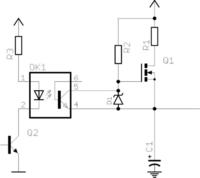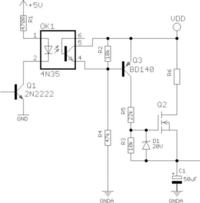Luis Blaugen
Newbie level 6

power mosfet driver
I have the following circuit: it’s a relaxation oscillator: R charges C (when mosfet is in saturation state) and when the C arrives to its maximum threshold voltage (83 v approximately), I must open the mosfet to start with the C discharge, but isolating the R, because I need to cut off this part of the circuit.
I try to open the mosfet giving a “1” to the base of 2N2222 transistor, so the opto-isolator led switch on its transistor (in fact I can’t realize this, I obtain a VSAT to high, nearly the value of the supply), closing the C-E junction of the BC639 and open the Mosfet.
All this would be the ideal that I pretend to happen, but I don’t realize my purpose, because the mosfet always conducts.
I attached the circuit sketch.
True Table: Base 2N2222 vs. Mosfet state:
base = 0 then Mosfet close (Saturation)
base = 1 then Mosfet is open
If my circuit doesn’t have a solution, why can I drive the mosfet?
Thanks and excuse me my grammar, I’m not American.
Luis Blaugen.
I have the following circuit: it’s a relaxation oscillator: R charges C (when mosfet is in saturation state) and when the C arrives to its maximum threshold voltage (83 v approximately), I must open the mosfet to start with the C discharge, but isolating the R, because I need to cut off this part of the circuit.
I try to open the mosfet giving a “1” to the base of 2N2222 transistor, so the opto-isolator led switch on its transistor (in fact I can’t realize this, I obtain a VSAT to high, nearly the value of the supply), closing the C-E junction of the BC639 and open the Mosfet.
All this would be the ideal that I pretend to happen, but I don’t realize my purpose, because the mosfet always conducts.
I attached the circuit sketch.
True Table: Base 2N2222 vs. Mosfet state:
base = 0 then Mosfet close (Saturation)
base = 1 then Mosfet is open
If my circuit doesn’t have a solution, why can I drive the mosfet?
Thanks and excuse me my grammar, I’m not American.
Luis Blaugen.





